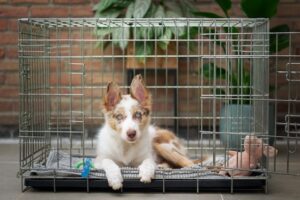Well, well, well… looks like we’ve got a real Toy Terminator on our hands!
That’s right, folks, we’re talking about our furry little friends who just can’t resist the urge to shred their toys to pieces.
If you’re a dog parent, you’ve probably experienced the pain of coming home to find your living room covered in bits of fluff and torn-up squeakers.
But fear not! Today, we’re going to delve into the reasons why dogs destroy their toys and share some remedies to help keep your house (and your wallet) intact.
So grab a cup of coffee, put on some protective gear, and let’s get started!
Why does my dog tear up his toys?
Dogs have a notorious reputation for tearing their toys to shreds, leaving us with a pile of fluff and a toy graveyard.
Although there are some common explanations for this behavior, the specific reasons for dogs destroying toys can vary from one dog to another. As this behavior can be destructive, it is crucial to understand the underlying causes of why your dog wants to destroy everything.
Given below are some of the possible reasons for this behavior:
- Boredom
- Pent-up energy
- Lack of mental stimulation
- Stress or anxiety
- Teething
- It’s the wrong toy for your pooch
- Plush toys are a target for dogs’ attack instinct
- Playing and destroying toys is fun for dogs
- Dogs may destroy toys to seek attention
1. Boredom
When your pet is destroying his plaything, it’s not a sign of aggression – It can simply be mindless behavior. Dogs are social animals and enjoy a range of activities. If they don’t have anything to interact with and are bored, they may resort to destruction because there is nothing else to do.
2. Pent-up Energy
Different dog breeds have different energy levels. An active & high-energy dog needs several walks or playing sessions in a day to tire them out. If they don’t get these outlets, they will look for other ways of release – such as shredding things to pieces.
3. Lack of Mental stimulation
Dogs are intelligent animals. Research shows that a dog’s level of mental abilities comes close to that of a 2 or 2.5-year-old human child. Surprised?
This means that dogs require a good amount of mental stimulation through games, and by exploring their surroundings.
If your pooch is cooped up all day without the necessary mental exercise, they may start to display destructive behavior of things around them.
4. Stress or Anxiety
If your dog displays problematic or destructive behavior, it may be the result of a stressful environment.
Do they start chewing their toys aggressively, or tearing their favourite stuffed animal when you’re about to leave for work? This could be a sign of separation anxiety.
They may also have difficulties adjusting to new changes, such as visitors, other dogs or new members of the family, causing them to be stressed out.
5. Teething
Dogs may also destroy their toys due to teething. When puppies are teething, they may chew on objects to relieve the discomfort in their gums.
This behavior is natural and typically stops once their adult teeth come in. Providing appropriate toys for teething puppies such as rubber toys and soft, non-edible chew toys can help redirect their chewing behavior and prevent them from damaging household items.
6. It’s the Wrong Toy for your pooch
A dog will try to destroy a toy if it is not suitable for them. For example, pit bulls or alsatians would need very sturdy big toys to play with, whereas a pug will love small and cute versions.
If you give too small a toy to your pitbull, they will definitely split the toy because their tough paws and powerful jawline are not well suited for the little soft toys.
6. Plush Toys Are a Target for Dogs’ Attack Instinct
Dogs have an inherent tendency to shake and kill. This is a reflexive instinct in them. Even the most gentle and timid dog species carry a part of their ancestral wolf DNA in their genome. The tendency to attack and kill is engrained in their genetic material.
The dogs that grow up in the wild are prone to shaking and killing their prey for self-defence and hunting. While the pet dogs never get to hunt in real life, the soft squeaky toys trigger their instinct.
Also, plush toys often resemble prey to dogs, and they enjoy tearing them apart. Dogs love to chew on things, and plush toys provide a satisfying texture to them.
7. Playing and Destroying Toys Is Fun for Dogs
It could be for fun. Maybe your dog is bored and wants something truly fun and entertaining for mental stimulation.
Destroying toys is one of the most fun things dogs love to do at any time and all the time. When the dog finds weak points in the toys, they love tearing them apart. Sometimes, the mere act of destruction brings them happiness and satisfaction.
6. Dogs May Destroy Toys to Seek Attention
It could be that your dog wants your attention. Dogs are social animals and enjoy interacting with their human companions.
They may engage in various activities, including destroying their toys, to get their owner’s attention. If your dog is gently gnawing on a toy or showing less aggressive behavior, it could be a sign that they want your attention.
Dogs may also seek attention by destroying cushions or other household items.
The good news is that there is a solution to this problem, so there’s no need to worry.
How do I stop my dog from destroying his toys?
Setting up the right environment for your pooch is the key to successfully training them out of bad habits.
- Train your dog appropriately
- Provide durable chew toys
- Adjust your approach for toy handling
- Offer rewards for good behavior
- Seek professional help
1. Train Your Dog Appropriately
The ideal approach is to teach them how to play with the toy. Sit with them and try to teach them how to handle the toy. Play hide and seek and fetch with the toy.
In this way, they will learn that the toy is meant for playing and not shredding. However, repeated teaching is needed to curb their tendency to shred soft plush toys.
2. Provide Durable Chew Toys
There is a type of pet toy called “chew toys” that are designed to satisfy a dog’s natural tendency to chew and rip things apart. These toys come in various forms, such as chew sticks and Nylabones, that are specially curated for dogs.
It’s always a good idea to consult your veterinarian before choosing a chew toy, as they can recommend which one is better suited for your furry friend.
Even if your dog destroys every toy you give them, a chew toy can still be a useful addition to their collection.
3. Adjust Your Approach for Toy Handling
Initially, offer the toy to your dog, but if you notice it starting to rip it apart, take it away strategically.
By doing so, your dog will learn that the toy will be withdrawn if they continue to tear it. Although it may take time to condition this behavior, it is a highly effective technique.
The goal is to teach your dog that destroying the toy will cause it to disappear, so they must refrain from dismantling it if they want to keep it.
4. Offer rewards for good behavior
Positive reinforcement given at the right time goes a long way in correcting bad habits. Give your pup access to toys as a reward for good behavior, and praise him when he plays calmly.
5. Seek professional help
If none of these methods works, or you notice that destruction happens out of stress or anxiety, it may be time to seek help from a professional trainer or dog behavior expert to fix any underlying issues and keep your pet safe.
So, what’s the bottom line?
Should You Let a Dog Destroy His Toys?
Absolutely not! Letting your dog destroy their toys is like giving them a blank check to a toy store.
Those things are expensive, and it’s just plain destructive behavior.
But that’s not all.
Letting your dog tear up his toys can also lead to health hazards,
Let me explain.
Firstly, if the toy has small parts or stuffing, your dog may swallow them, which can lead to choking or intestinal blockages.
Secondly, if the toy is made of materials that are not safe for your dog to ingest, such as plastic or certain fabrics, your dog may suffer from digestive problems or even poisoning.
Thirdly, if your dog has a habit of destroying toys, it may develop a taste for chewing on other household items, which can be dangerous and costly to replace.
Finally, if your dog is left unsupervised with a destroyed toy, it may continue to chew on it and ingest dangerous materials.
Therefore, it is important to supervise your dog when playing with toys, regularly inspect the toys for damage, and remove any toys that are damaged or destroyed to keep your dog safe and healthy.









